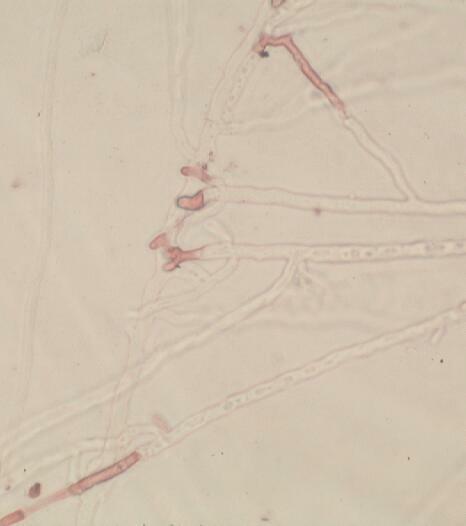The fungus Heterobasidion annosum is the most damaging root pathogen of coniferous trees in the Northern hemisphere. It progresses from the roots into the base of a tree, causing an economically important butt rot. Once established in a site, the fungus is almost impossible to eradicate; it spreads progressively by contact of healthy roots with infected roots, causing disease gaps (A) in which many of the trees have died (B) and may have bracket-shaped fruitbodies of Heterobasidion at their base (C). These fruitbodies release air-borne basidiospores which can spread the infection to new sites. This occurs typically when trees are felled. Basidiospores land on the freshly cut stump surfaces, and the fungus grows down through the stump tissues to the dead roots, from which it can infect the roots of adjacent healthy trees. |
||||
 A, B, C, E and F: from colour transparencies kindly supplied by the late John Rishbeth. |
||||
H. annosum is a specialised pathogen, so it initially has a selective advantage over other fungi in colonising the freshly exposed stump tissues. But, once these tissues have died they can be colonised by a range of harmless decay fungi which can exclude the pathogen by competition. For this reason, foresters usually kill the stump surface tissues with mildly toxic chemicals such as urea, boron compounds or ammonium sulphamate. However, this can be environmentally undesirable and in some cases, especially for pine stumps, it can be replaced by a highly effective biological control system devised by Dr John Rishbeth at the Cambridge Botany School. He found that fresh pine stumps can be colonised by another fungus, Phlebiopsis gigantea (previously called Peniophora gigantea), which is weakly parasitic but poses no danger to healthy trees. If Phlebiopsis is applied first then it can prevent invasion by H. annosum, protecting the stump surfaces without the need for phytotoxic chemicals. He developed a simple method of commercialising P. gigantea, because this fungus grows readily in laboratory culture, producing large numbers of brick-like spores by fragmentation of the hyphae (D). The harvested spores were suspended in a sucrose solution, to raise the osmotic potential and prevent them from germinating during storage, then mixed with a dye and sealed into sachets (E) that can be stored for up to 6 months in a refrigerator. For application, the contents of the sachets are diluted with water and sprayed onto fresh stump surfaces. The fungus colonises rapidly and produces its bracket-shaped fruitbodies about one year later (F). P. gigantea has an interesting mode of action as a biological control agent. The hyphae of this fungus antagonise the hyphae of H. annosum (and some other fungi) on contact - a phenomenon termed hyphal interference (G). Any hypha of H. annosum that makes contact with a hypha of P. gigantea shows rapid, localised disruption: the protoplasm becomes disorganised and its membrane integrity is affected. This is shown in Figure G, where the dye neutral red was added to an agar plate: several hyphae of H. annosum have grown up to a hypha of P. gigantea and have locally taken up the dye whereas their normal membrane integrity would exclude this dye (see below).
According to Michelle Cram (see Phanerochaete gigantea - not on this server), P. gigantea is commercially available in Britain, Sweden, Norway, Switzerland and Finland, as either a spore suspension or a dry product (named "Rotstop"). It was available in the USA until 1995 when the Environmental Protection Agency required it to be registered officially as a biological pesticide - a relatively expensive process that probably would not be cost-effective for the commercial producers. |
||||
Further reading:
Website - Annosum root rot (not on this server) |
||||

